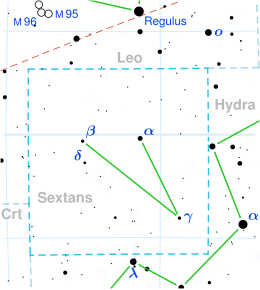| Observation data Epoch J2000.0 Equinox J2000.0 (ICRS) | |
|---|---|
| Constellation | Sextans |
| Right ascension | 09h 53m 42.92424s[1] |
| Declination | +05° 57′ 30.8742″[1] |
| Apparent magnitude (V) | 5.95[2] (5.89 - 5.95)[3] |
| Characteristics | |
| Evolutionary stage | AGB[4] |
| Spectral type | M2.5 III[5] |
| U−B color index | +1.93[6] |
| B−V color index | +1.66[6] |
| Variable type | suspected[7] |
| Astrometry | |
| Radial velocity (Rv) | −0.66±0.40[8] km/s |
| Proper motion (μ) | RA: −3.026 mas/yr[1] Dec.: +1.315 mas/yr[1] |
| Parallax (π) | 2.9474 ± 0.107 mas[1] |
| Distance | 1,110 ± 40 ly (340 ± 10 pc) |
| Absolute magnitude (MV) | −1.30[9] |
| Details | |
| Radius | 133±7[10] R☉ |
| Luminosity | 1,918±144[11] L☉ |
| Surface gravity (log g) | 0.469[12] cgs |
| Temperature | 3,622±125[12] K |
| Metallicity [Fe/H] | +0.23[13] dex |
| Other designations | |
| Database references | |
| SIMBAD | data |
HD 85709 (HR 3915; 14 G. Sextantis; NSV 18292) is a solitary star[15] located in the equatorial constellation Sextans. It is faintly visible to the naked eye as a red-hued point of light with an apparent magnitude of 5.95.[2] The object is located relatively far at a distance of 1,100 light-years based on Gaia DR3 parallax measurements but it is slowly drifting closer with a heliocentric radial velocity of −0.66 km/s.[8] At its current distance, HD 85709's brightness is diminished with an interstellar extinction of two-tenths of a magnitude[16] and it has an absolute magnitude of −1.30.[9]
HD 85709 has a stellar classification of M2.5 III,[5] indicating that it is an evolved M-type giant star. It is currently on the asymptotic giant branch,[4] the point where it is generating energy via the fusion of hydrogen and helium shells around an inert carbon core. Having expanded to 133 times the radius of the Sun,[10] it now radiates 1,918 times the luminosity of the Sun[11] from its enlarged photosphere at an effective temperature of 3,622 K.[12] HD 85709 is metal enriched with an iron abundance 1.58 times that of the Sun's.[13]
In 1991, astronomer V.G. Kornilov and colleagues observed that HD 85709 fluctuated between magnitudes 5.89 and 5.95 in optical light during a photometry survey.[3] As of 2004 however, its variability has not been confirmed.[17]
- ^ a b c d Cite error: The named reference
GaiaDR3was invoked but never defined (see the help page). - ^ a b Cite error: The named reference
Ducati2002was invoked but never defined (see the help page). - ^ a b Cite error: The named reference
Kornilov1991was invoked but never defined (see the help page). - ^ a b Cite error: The named reference
Eggen1992was invoked but never defined (see the help page). - ^ a b Cite error: The named reference
Wilson1950was invoked but never defined (see the help page). - ^ a b Cite error: The named reference
Johnson1966was invoked but never defined (see the help page). - ^ Cite error: The named reference
Samus2017was invoked but never defined (see the help page). - ^ a b Cite error: The named reference
Famaey2005was invoked but never defined (see the help page). - ^ a b Cite error: The named reference
Anderson2012was invoked but never defined (see the help page). - ^ a b Cite error: The named reference
Kervella2004was invoked but never defined (see the help page). - ^ a b Cite error: The named reference
GaiaDR2was invoked but never defined (see the help page). - ^ a b c Cite error: The named reference
McDonald2017was invoked but never defined (see the help page). - ^ a b Cite error: The named reference
Zhou1991was invoked but never defined (see the help page). - ^ Cite error: The named reference
Gould1879was invoked but never defined (see the help page). - ^ Cite error: The named reference
Eggleton2008was invoked but never defined (see the help page). - ^ Cite error: The named reference
Gontcharov2017was invoked but never defined (see the help page). - ^ Cite error: The named reference
Samus2004was invoked but never defined (see the help page).
